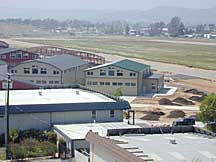Site Survey/RF Interference 
An important factor to take into consideration when you are choosing your wireless system and installation locations is the presence of other RF transmitters. This is particularly important in industrial and metropolitan areas, but should always be taken into consideration with any installation. One of the first things that you should do before you purchase your wireless video system is to conduct an inspection of the installation site(s) for other RF transmitters. When choosing the locations to install the receivers, it is important to ensure that they are not being placed next to any high-power RF transmitters. One commonly overlooked source of interference in the 2.4 GHz ISM band is the conventional microwave oven. It is important that the Eagle PLUS receivers and transmitters be mounted as far from microwave ovens as possible. If that is not feasible, you may need to consider using the Falcon PLUS 5.8 GHz system or shielding the microwave oven externally. If you have selected a location without visible transmitters, you probably will not have any problems caused by interference. However, it is always best to test the system at the site before you permanently install it to avoid complications. If there are visible RF transmitters at your installation site, you should perform one of the following checks to help ensure that you do not experience complications during installation. 1. Spectrum Analyzer: If you have access to a spectrum analyzer, you can use it to perform a site survey, which can provide you with accurate information about the frequencies and power levels of RF transmitters at your site. This is only recommended for customers who have experience with RF and have test equipment that is readily available. 2. Built-in RSSI: The best approach for most users will be to take a receiver to the installation site. You will want to use the same type of system and antenna that you are planning to use for that application. When you are on site, power the system up with the receiver antenna attached. Place the receiver in RSSI mode by pressing and holding the toggle/RSSI switch until all LEDs are lit. After you release the switch, the receiver will then be in RSSI mode and the LEDs will indicate the received signal strength. NOTE: For PTZ-900, RSSI mode is turned on via the PC interface software. It is important to check RSSI with the transmitter turned off and on since you are trying to check for an existing signal that may interfere with yours. If the RSSI is indicating a received signal strength of two LEDs or less there should not be a problem. If it indicates more than two, you will want to try to locate the source and isolate the receiver from it as much as possible. If at all possible, the complete system should be tested in place before it is installed wherever there is a chance of interference. | 
